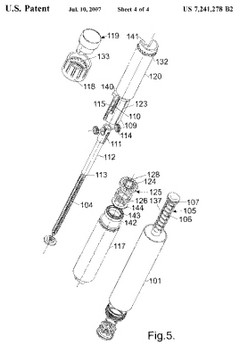
Novo sued Sanofi alleging infringement of its patent covering an insulin pen. In a Feb 19, 2008 order, the district court denied Novo’s request for a preliminary injunction – finding that Sanofi has a strong non-infringement argument. On appeal, the CAFC quickly affirmed.
The decision to not issue a preliminary injunction rests within the discretion of the district court.
We will reverse such a decision only when an appellant demonstrates that the “factors relied on by the district court [were] clearly erroneous” and “that a denial of the preliminary relief sought would amount to an abuse of the court’s discretion upon reversal of an erroneous finding.” New Eng. Braiding Co. v. A.W. Chesterton Co., 970 F.2d 878 (Fed. Cir. 1992).
In this case, the district court did not construe the claims prior to denying the PI request. It did note, however, that “questions exist” as to whether the patented invention requires direct gearing and a non-rotatable piston — elements not found in the accused product.
In its appellate decision, the CAFC found that the lower court had acted properly in denying the PI request without deciding the claim construction issue:
At the preliminary injunction stage, however, it is irrelevant whether this case presents greater issues of claim construction or validity—the existence of one or both of these issues is sufficient to justify the district court’s decision to deny a preliminary injunction.
Affirmed
-
Note: My former firm, MBHB, represents Sanofi-Aventis in this appeal.
First hand knowledge is a wonderful thing Mooney. By the way, Pollyanna wants her lunch box back
“Eeeeyeah right. NOT!”
I’m guessing 6th grade. Maybe 7th.
I look forward to your numbers, Dennis. My sense is that a PI granted by the district court and affirmed by the CAFC has become an endangered species.
“Typical medical device horsecrap?” And again with the crack references?
Its this kind of pithy analysis that I’m sure all the readers of Patently-O anxiously await every day. Eeeeyeah right. NOT!
I hope you work by yourself Mooney, because I wouldn’t want to be around you. I can barely stand to be on the same blog. I’m sure the people you know are quietly saying these kinds of things behind your back.
“The Federal Circuit should quit the charade, or the Supremes should step in and finally decide what everyone knows — claim construction is a mixed question that usually involves subsidiary factual questions that should be reviewed for clear error.”
I agree with that.
“A court cannot deny a PI that turns solely on a question of law (which appears to be the case here) by saying that that question of law is just real hard to figure out .”
Is that what happened here? Seems to me the District Court is saying that the injuction is not proper because you have to be the patentee or high on crack to believe that infringement is occurring.
A clear, clear example of the Federal Circuit’s schizophrenic approach to claim construction. IF claim construction is an issue of law — as the CAFC says it is — then is decision is utterly unjustifiable. A court cannot deny a PI that turns solely on a question of law (which appears to be the case here) by saying that that question of law is just real hard to figure out . . . . The Federal Circuit should quit the charade, or the Supremes should step in and finally decide what everyone knows — claim construction is a mixed question that usually involves subsidiary factual questions that should be reviewed for clear error.
Interestingly, there was a news bit here from 3rd March stating that the PI was the poor man’s road to a quick appeal on the claim constructions. Now the district courts are being told they needn’t construe claims before making a PI decision?
“In this case, the district court did not construe the claims prior to denying the PI request. It did note, however, that “questions exist” as to whether the patented invention requires direct gearing and a non-rotatable piston — elements not found in the accused product.”
Gosh, the claims are typical medical device horsecrap, designed to confuse the unfortunate reader (i.e., the Examiner and the public). But let’s look at the specification and see what it says: “It is an objective of the invention … to provide a device wherein is established a direct gearing, i.e. a gearing by which more transformations of rotational movement to linear movement and linear movement to rotational movement are avoided, between the injection button and the piston rod.”
So the district court was being kind. There are no “questions” about non-infringement. So why did Novo Nordisk file this lawsuit? Answer: Because they have a patent and it’s often useful to beat their competitors over their heads with it. The risk of being sanctioned for harassment is just about nil and even then the sanctions would probably not outweigh the benefits of swinging the baseball bat around and letting everyone know how “serious” they are about their IP.
And let’s be frank. It’s 2008. A non-obvious syringe is like a non-obvious candy bar. Anybody who has ever worked in a lab or hospital knows that, like “energy drinks,” the success of these products is 95% due to the way they are peddled to the middlemen in the supply chain.
The CAFC has quietly been doing a very good job of turning-around preliminary injunction cases (as well as those involving a stay of relief). I’m working on some numbers.
“the CAFC quickly affirmed”
I’ll say. Twenty day turnaround. Oral argument on 7/10, opinion on 7/30.
“it is irrelevant whether this case presents greater issues of claim construction or validity—the existence of one or both of these issues is sufficient”
So if the existence of an issue is sufficient to justify a decision, it is irrelevant whether the issue is presented?
Comments are closed.